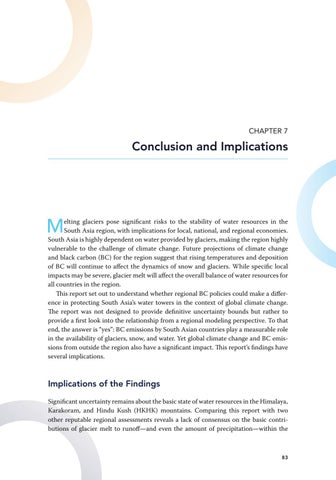CHAPTER 7
Conclusion and Implications
M
elting glaciers pose significant risks to the stability of water resources in the South Asia region, with implications for local, national, and regional economies. South Asia is highly dependent on water provided by glaciers, making the region highly vulnerable to the challenge of climate change. Future projections of climate change and black carbon (BC) for the region suggest that rising temperatures and deposition of BC will continue to affect the dynamics of snow and glaciers. While specific local impacts may be severe, glacier melt will affect the overall balance of water resources for all countries in the region. This report set out to understand whether regional BC policies could make a difference in protecting South Asia’s water towers in the context of global climate change. The report was not designed to provide definitive uncertainty bounds but rather to provide a first look into the relationship from a regional modeling perspective. To that end, the answer is “yes”: BC emissions by South Asian countries play a measurable role in the availability of glaciers, snow, and water. Yet global climate change and BC emissions from outside the region also have a significant impact. This report’s findings have several implications.
Implications of the Findings Significant uncertainty remains about the basic state of water resources in the Himalaya, Karakoram, and Hindu Kush (HKHK) mountains. Comparing this report with two other reputable regional assessments reveals a lack of consensus on the basic contributions of glacier melt to runoff—and even the amount of precipitation—within the
83




